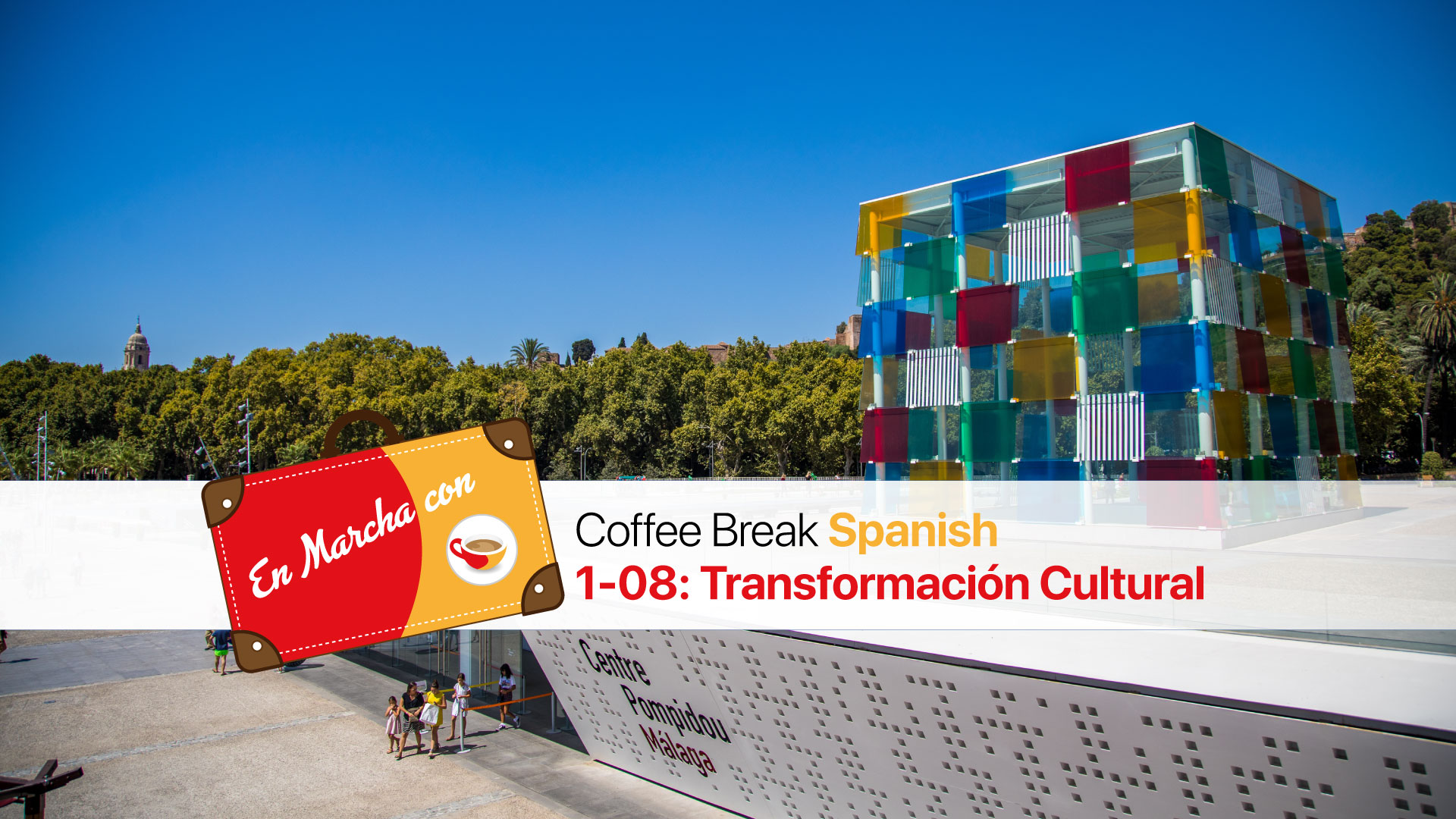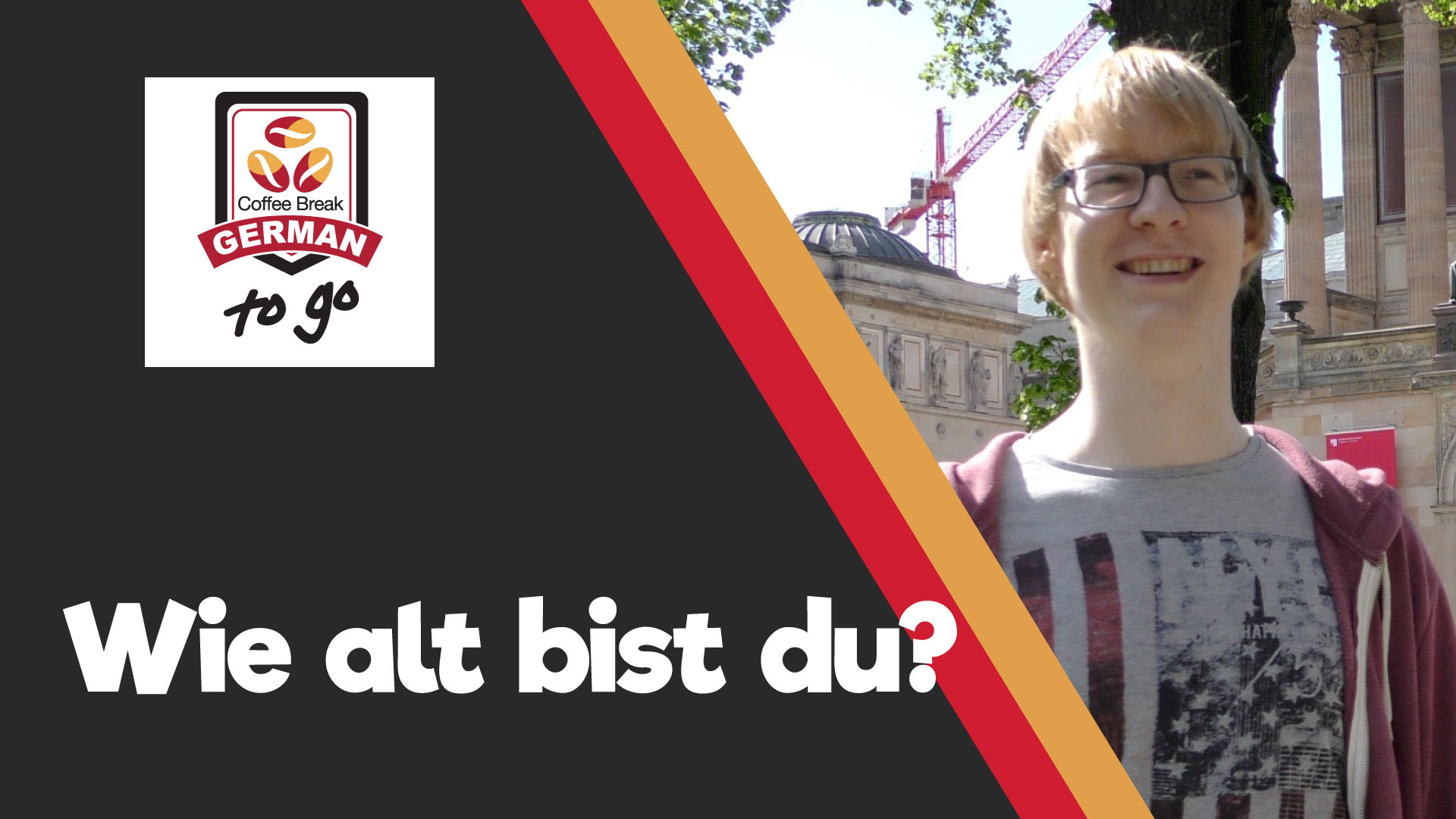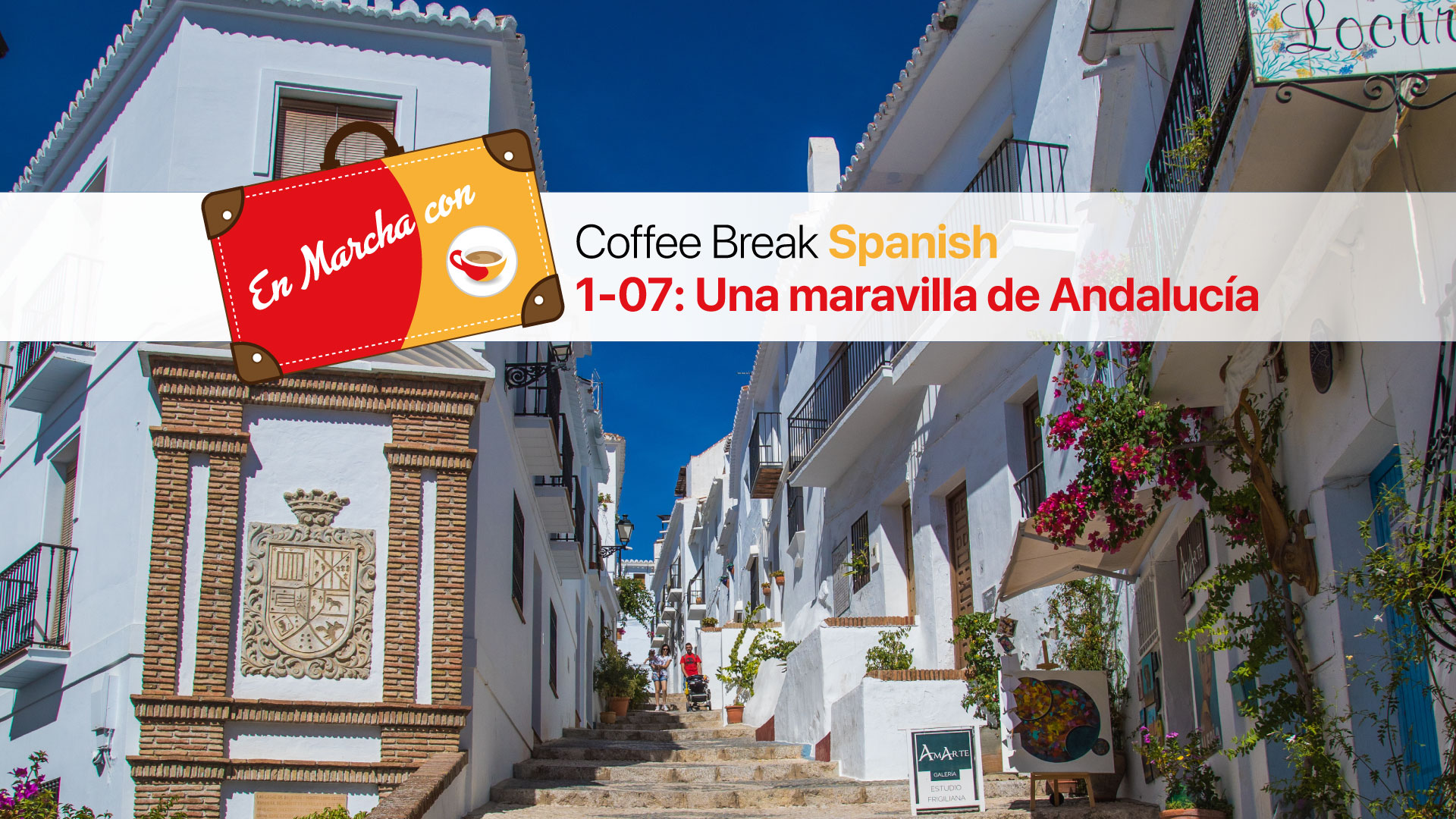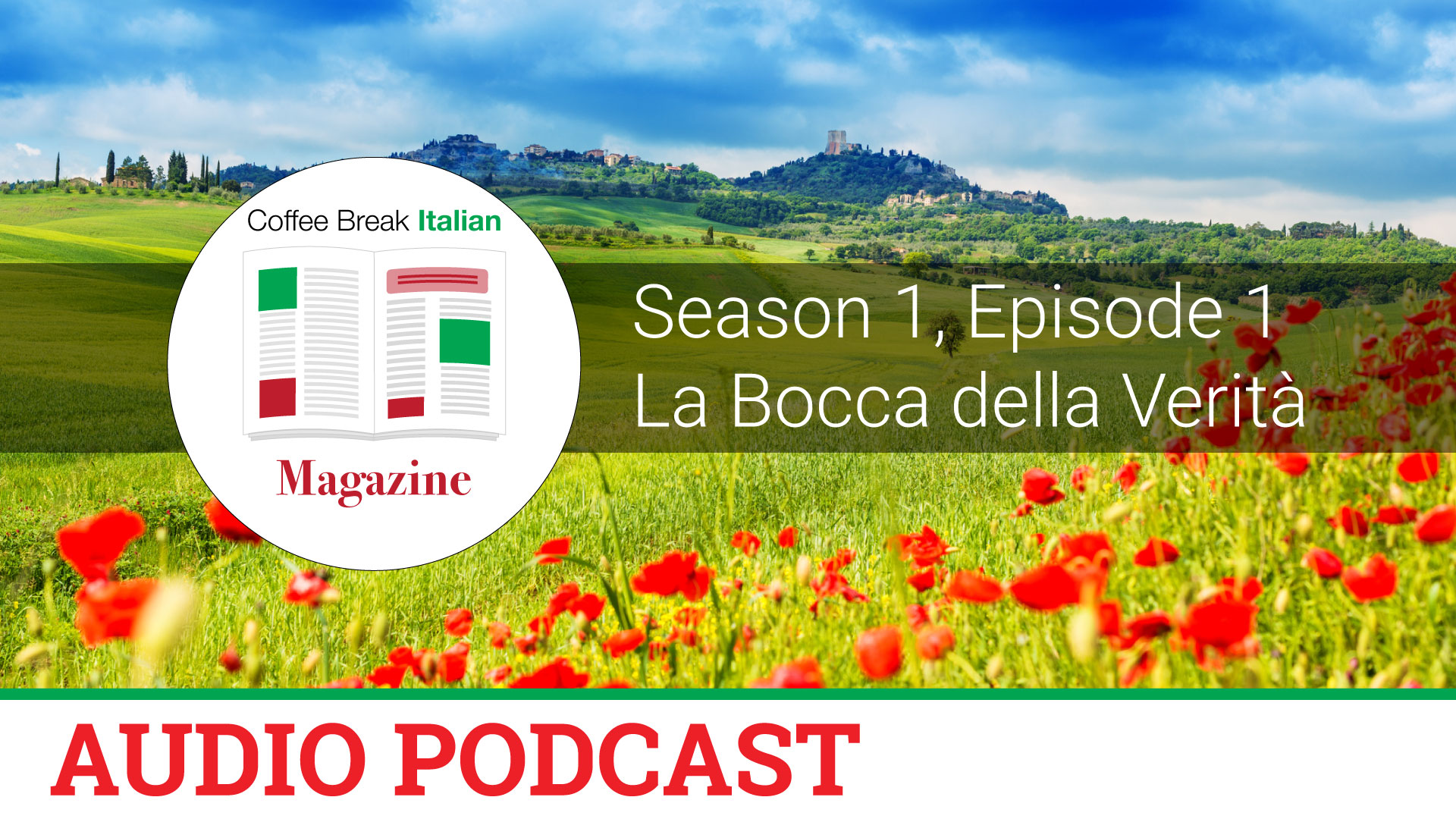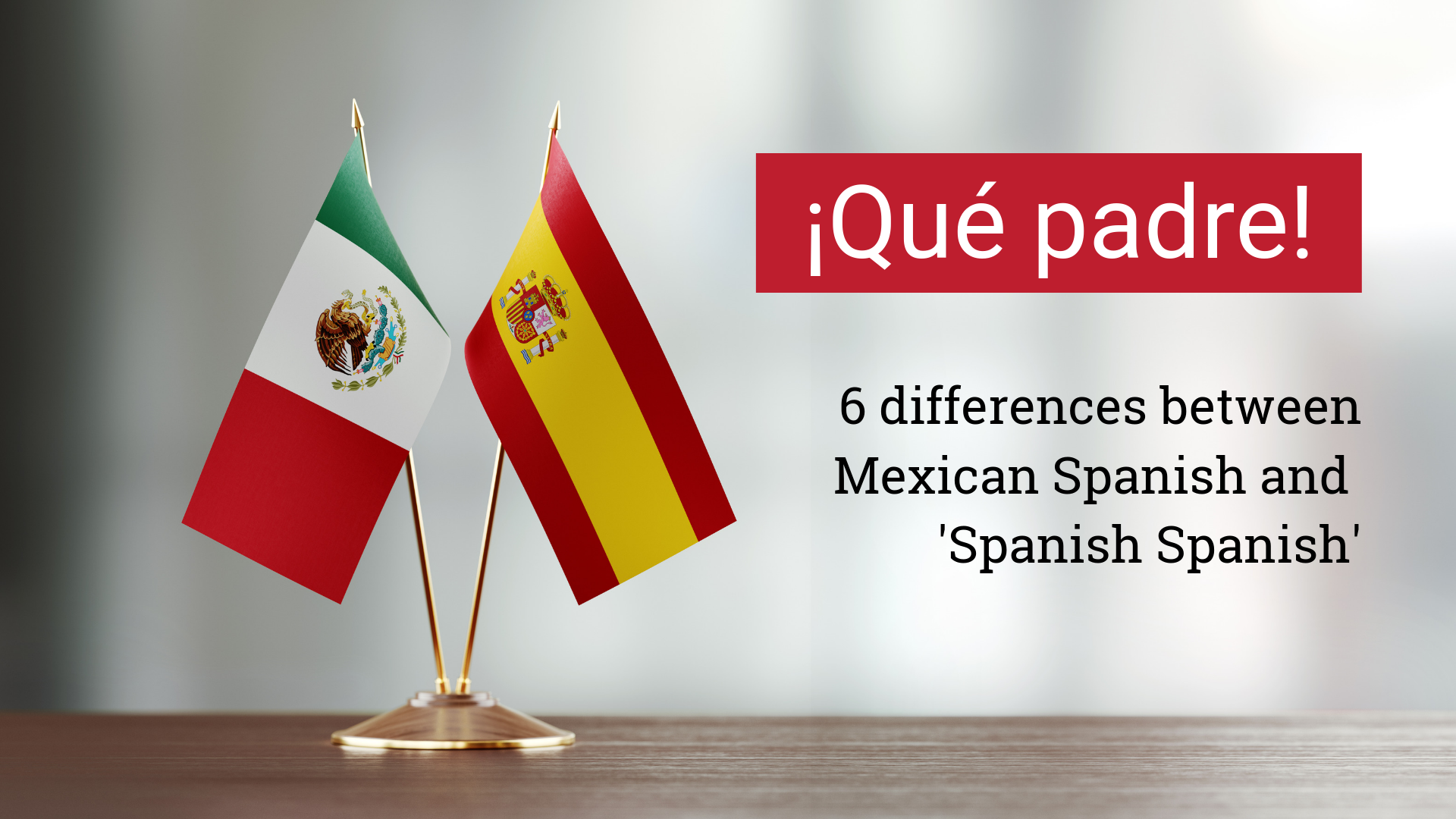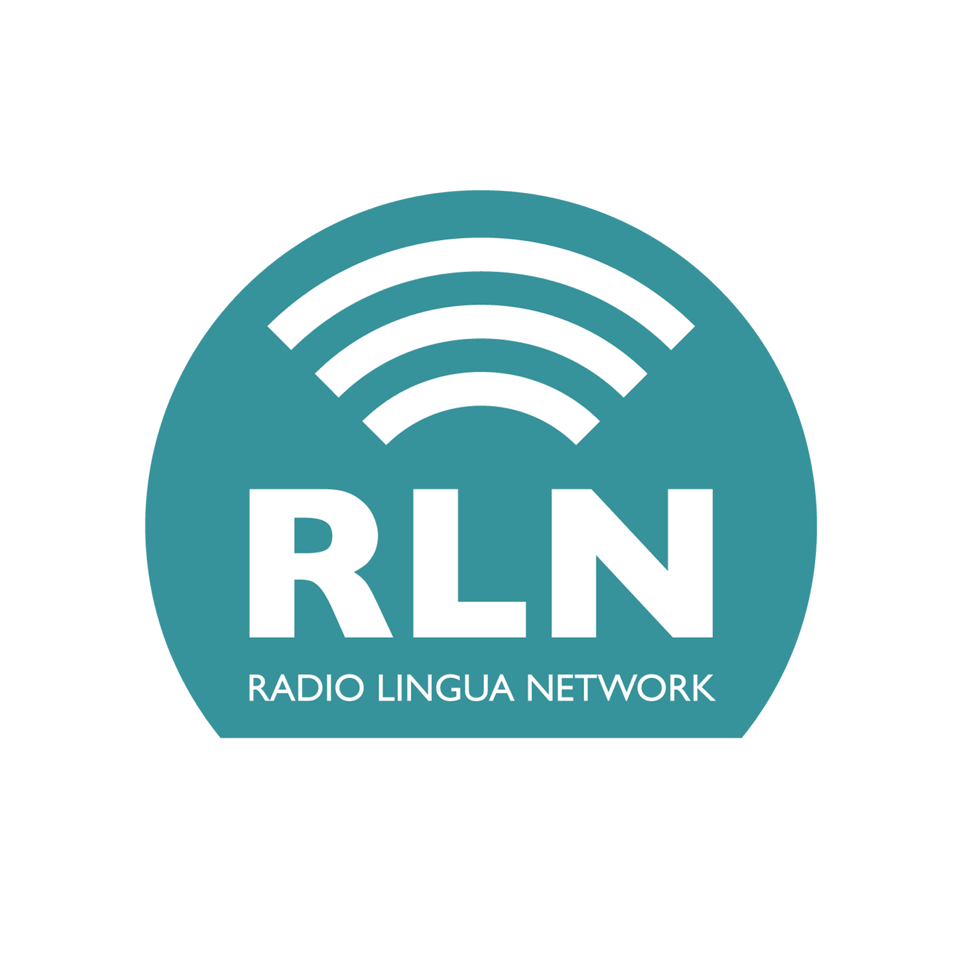We have a special edition of the Coffee Break Catch-up this week which was recorded live in Milan, Italy. Join Mark and Francesca who are filming some future Coffee Break Italian content. We’ll be telling you more about this in this edition, along with our usual collection of information about the latest Coffee Break episodes and cultural events around the world.
Month: May 2019
CBF Mag 1.02 | Saint Exupéry
In Episode 2 of Season 1 of the Coffee Break French Magazine, we discuss the French author and aviator Antoine de Saint-Exupéry, author of Le Petit Prince. In the Q&A section, Mark discusses the difference between the imperfect and perfect tenses in response to Keith’s question.
In each episode of this 10-lesson season for intermediate learners, you can build your vocabulary, increase your understanding of grammar and learn to use the French language in a more natural way. This series is aimed at learners who have completed at least Season 1 and Season 2 of Coffee Break French.
CBS EM 1.08 | Málaga: Transformación Cultural
What springs to mind when you think of the city of Málaga? Until recently, it may have been the great weather and the beaches. But nowadays, the city has shaken off the dated image of sol y playa, and is establishing itself as one of Spain’s main cultural hubs. In this episode, through a series of interviews with local professionals, we hear about what led to this cultural transformation, and the opening of new museums and galleries across the city.
The Coffee Break Catch-up: 23 May 2019
Join Coffee Break Founder and CEO Mark for this week’s edition of the Coffee Break Catch-up, our weekly show in which we’ll update you on all things Coffee Break Languages. There are discussions on language learning, and a roundup of some of the cultural events happening around the world.
In this edition:
- Updates on our latest episode of the Coffee Break Italian Magazine and our One Minute Japanese course on YouTube;
- news of a special fund-raising project we’re running this week to support Dementia Awareness week;
- discussion about the development of the English language and the science of etymology, the study of the origins of words;
- cultural news from around the world.
Wie alt bist du? Talking about your age in German – Coffee Break German To Go Episode 1.04
To ask “where age are you?” in German you can say wie alt bist du?, or in a more formal situation, wie alt sind Sie? Literally this means “how old are you?” In this episode of Coffee Break German To Go, Julia asks this questions to interviewees in the streets of Berlin. You can use the answers of our interviewees to help you learn to answer this question yourself.
In the first part of the video, watch the interviews without subtitles and try to understand. In the second part of the video, we’ve provided subtitles in German at the top of the screen. You can choose to turn on subtitles in English using the Subtitles/CC button.
In our first series, Julia is in the city of Berlin, and in each episode she’ll ask passers-by one question. Of course, that one question will result in many answers, and it’s through these answers that you can practise your German and build your vocabulary.
If you’d prefer not to wait for all 10 lessons of Season 1 to be published, you can access downloadable versions of the videos along with audio versions and lesson notes / transcripts in the Coffee Break Academy:
https://coffeebreakacademy.com/p/coffee-break-german-to-go-season1/
Coffee Break German To Go is based on the popular podcast series and online course Coffee Break German. For access to the free podcasts, please click below:
https://coffeebreaklanguages.com/tag/cbg-season-1/?order=asc
To purchase our full online courses on the Coffee Break Academy, click below:
https://coffeebreakacademy.com/courses/category/German
An Introduction to the French of Quebec
Canada has one province whose sole official language is French: Quebec. Although many Quebecers, or Québécois, are bilingual in English and French (or speak another language as their mother tongue), about 85% still speak French as their first language. While Quebec City (la Ville de Québec) is the province’s capital, Montreal (Montréal) is its largest city. Behind Paris, Kinshasa (Republic of Congo) and Abidjan (Ivory Coast), Montreal is the 4th largest French-speaking city in the world.
So, when planning a trip to practise your French, why not consider crossing the Atlantic to discover French-speaking Canada? If you do, not only will you get the chance to discover the beautiful old-town of Quebec and have a taste of some poutine, but you’ll also be greeted by a new accent and many differences in vocabulary from the standard French you may have been learning. Here are four aspects of québécois French which prove that learning another dialect of a language can be a wonderfully enriching experience!
1. Je prends mon déjeuner à 8 heures et mon dîner à 12 h 30
Surprised? Here’s difference number one between French in France and Canadian French:
For the French, their breakfast is le petit déjeuner, lunch is called le déjeuner and dinner is le dîner. French Canadians, however, opt for:
breakfast le déjeuner
lunch le dîner
dinner le souper
So don’t be confused if you understand someone as saying they have lunch as soon as they get out of bed! Note that these words can also be heard in Belgium and Switzerland.

2. Your boyfriend is your buddy and your girlfriend is your blonde!
You may have learned mon petit-ami to mean ‘my boyfriend’ and ma petite-amie to mean ‘my girlfriend’. However, in French Canada, your boyfriend is your chum and your girlfriend is your blonde, regardless of her hair colour!
For example:
Voici mon nouveau chum. – “This is my new boyfriend”.
Voici ma nouvelle blonde. – “This is my new girlfriend”.
Just be aware that, while the word ‘blonde’ doesn’t necessarily have derogatory connotations, it is a slang word which should only be used in informal, conversational contexts.
3. C’est là là !
As you may already know, là can be translated as ‘there’ and is used in standard French in contexts such as je l’ai trouvé là (“I found it there”). However, in informal, spoken québécois French, this two-letter word is found at the end of many sentences, often without a translatable meaning!
It is often used for emphasis or to add more emotion to a statement. For example, if you’re getting frustrated at a person who is looking for something which is right in front of their nose, you might say regarde, c’est là là ! While the first là would be explaining the position of the object, the second one is almost like a spoken exclamation mark, expressing the speaker’s impatience.

4. Les anglicismes
Finally, in case you’re starting to worry about having to learn a whole new language when travelling to French-speaking Canada, don’t panic – many English words are used too!
In larger cities, like Montreal, French and English merge together and influence one another, sometimes referred to as franglais. Some young Québécois will even start a conversation in French then suddenly change into English and back into French again within a few sentences.
This means that québécois French borrows and adapts many words from English.
Here are some of the most common ones:
English / standard French / québécois French
to check / vérifier / checker
to direct or “be the boss of” / diriger / bosser
cute / mignon / cute (English pronunciation)
anyway / de toute façon / anyway (English pronunciation)
a joke / une blague / une joke (English pronunciation)
Sometimes, it’s almost easier for English speakers to understand what a québécois person is saying than it is for people who speak standard French!
Of course, the idea of travelling to a place with an unfamiliar accent and new vocabulary that you haven’t learned may seem daunting, but we hope you can see how interesting and fun it can be visiting many different countries where the language you’re learning is spoken.
Have you had any experience travelling to a country where the language you’re learning is spoken with an unfamiliar accent and vocabulary? Share your stories in the comments section below!
À tout à l’heure, or à tantôt, as they say in Quebec!
CBI Mag 1.02 | Il Gargano – la Perla della Puglia
In this episode we’re heading south to the region of Puglia and, more specifically, to the area known as Il Gargano. Known for its crystalline waters and golden beaches, there is much to see and do in Il Gargano. Find out more in the episode. Francesca and Mark also have some advice on how to learn vocabulary, based on Tricia’s question. The episode concludes with a scioglilingua – a tongue twister – which will help you practise the ‘gl’ sound in Italian.
7 Reasons Why Learning Norwegian is Kjempefint!
Each year, the 17th May marks a very important date in the Norwegian calendar. With marvellous parades and celebrations, Norwegian Constitution Day, known as Nasjonaldagen (National Day), Grunnlovsdagen (Constitution Day) or simply Syttende Mai (17th May), is celebrated in good spirit, and in style. So, here at Coffee Break Languages we thought that there was no better time than today to talk about the interesting aspects of the Norwegian language, and why learning it is kjempefint – “really great”!
1. Ja, vi elsker dette landet!
The Norwegian National Anthem begins with the line “yes, we love this land”, and really, how could you not? With some of the most beautiful places you’ll ever see, Norway must be in the top 5 most Instagrammable countries you’ll ever visit! Of course, if you can speak litt norsk (a little Norwegian), then your experience there will be all the more fulfilling. There’s a whole year until next Syttende Mai, so if you start learning some key phrases perhaps you can take a trip to Norway next year and join in the celebrations.

2. Two for the price of one
Believe it or not, there are actually two official, recognised versions of written Norwegian. They’re called Bokmål (literally “book tongue”) and Nynorsk (new Norwegian). Children in Norwegian schools have to learn both forms, but no-one really speaks either form: everyone speaks their own dialect! Don’t worry though – it is likely that most dialects will be understood by most Norwegian speakers, as Norwegians are used to hearing different dialects all the time.
3. One word + one word = much more than two words
There are a huge number of compound words in the Norwegian language, and very often the word takes on a whole new meaning. Take, for example soloppgang which literally means “sun up going”. This is the word used for “sunrise”. Or, if you have fire (ild) in your soul (sjel) about a particular cause then you’re an “enthusiast”: ildsjel. Our favourite compound word in Norwegian, however, has to be the word for “outer space”. Going back to Norse mythology, Odin established the different realms (or “rooms”) of the universe, making “outer space” verdensrommet, or “the room of the world”.

4. Sitt under the tre with your søster and read your bok
Guess what? There are already many words in the Norwegian language that you already know! There are a huge number of cognates – words with similar roots – between English and Norwegian and you’ll be able to work out the meaning of many Norwegian words simply by listening to them or reading them. Some examples are bok (“book”), tre (“tree”), over (“over”), familie (“family”), søster (“sister”), telefon (“telephone”), but there are lots more! English and Norwegian are both Germanic languages and therefore they’re related.
5. Jeg er, du er, han er, hun er…
Perhaps the best news of all when it comes to learning Norwegian is the fact that grammatically it’s really quite easy! If you’re used to six forms of conjugated verbs in other languages such as Spanish or French, worry no more. In Norwegian there’s just one form for each tense! So “I am” is jeg er; “you are” is du er; “he is” is han er; and “she is” translates as hun er. That means that “am”, “are” and “is” in English are all simply translated by one word in Norwegian: er. Så lett – so easy!
6. Three for the price of one
There’s another bargain to consider! If you understand Norwegian then you’ll be able to understand a fair bit of Swedish as many words are similar: to say “I understand a little English” a Norwegian would say jeg forstår litt engelsk and a Swede would say jag förstår lite engelska. And that’s not all: since written Norwegian (Bokmål) was based on written Danish, Norwegians can understand written Danish very easily. You’ll even be able to recognise words in Icelandic and Faroese, two other languages which derived from Old Norse.
7. You can learn in minutes – for free!
To celebrate Syttende Mai, we’re making our One Minute Norwegian course available on YouTube from today. With these ten short lessons presented by native speaker Dag, you’ll quickly pick up the basics of this beautiful language. The lessons cover greetings, introductions, counting and you’ll learn to say that you speak a little Norwegian. Although Norwegians generally speak amazing English, you can guarantee that when you say jeg snakker litt norsk to a native speaker they’ll smil from øre to øre!
So, whether you’re interested in travelling to this fantastic country, have a go at learning a different language, or want to get your foot in the door of understanding Scandinavia and all it has to offer, Norwegian could be the key to a treasure chest of Nordic delights!
Have you visited Norway? Have you tried learning any Norwegian? Let us know in the comments below.
The Coffee Break Catch-up: 16 May 2019
Join Coffee Break Founder and CEO Mark for this week’s edition of the Coffee Break Catch-up, our weekly show in which we’ll update you on all things Coffee Break Languages. There are discussions on language learning, and a roundup of some of the cultural events happening around the world.
In this edition:
- looking back at the launch of our Coffee Break French Magazine and some new information about the next edition of the Coffee Break Italian Magazine;
- News of our One Minute Norwegian course now available on YouTube;
- there’s a discussion about constructed and artificial languages: would you want to learn Esperanto, Dothraki or High Valyrian?;
- and we round up some of the cultural highlights happening around the world this week.
CBF Mag 1.01 | La Raclette
The Coffee Break French team is back with a new series, the Coffee Break French Magazine. In each episode of this 10-lesson season for intermediate learners, you can build your vocabulary, increase your understanding of grammar and learn to use the French language in a more natural way. This series is aimed at learners who have completed at leats Seasons 1 and 2 of Coffee Break French.
There will be a total of 10 episodes in Season 1 of the Coffee Break French Magazine. If you’d like to benefit from lesson notes, transcripts, vocabulary lists and exercises, you can access the premium version of the Magazine on the Coffee Break Academy. Scroll down for more information.
CBS EM 1.07 | Una Maravilla de Andalucía
In this 7th episode of En Marcha, Mark and the team head eastwards along the Costa Tropical, to the village of Frigiliana, officially one of the most beautiful villages in Spain. After spending the day finding out about the village through both its residents and its visitors, it’s time to return to Málaga, but not before dropping in on two more villages, one of which offers up an opportunity for Mark to catch up with some familiar faces. For more information about High Five Spanish, our Spanish course for children, please visit http://highfivespanish.com.
The Coffee Break Catch-up: 9 May 2019
Join Coffee Break Founder and CEO Mark for the latest edition of the Coffee Break Catch-up, our new weekly show in which we’ll update you on all things Coffee Break Languages. There are discussions on language learning, and a roundup of some of the cultural events happening around the world.
In this edition:
- further information about our forthcoming launch of the Coffee Break French Magazine which will be broadcast in an “avant-première” on Monday 13th May;
- there’s a discussion about resources, apps and podcasts which complement Coffee Break language courses;
- and we round up some of the cultural highlights happening around the world this week.
Meet Yvonne, Coffee Break Italian learner
Tell us who you are, where you live, your nationality and how long you’ve been learning a language with us.
What experience have you had speaking and learning other languages?
What are your favourite memories of learning a language?
Where would your ideal coffee break be, and with whom?
What’s the best language-learning tip you have found works for you?
Quick Fire Round
- Your favourite language: Italian
- Your favourite word or phrase in the language: vino
- Do you have a favourite film, TV show, book or singer in the language? Pane e Tulipani
- Your favourite destination to practise your language: Italy
Please finish off with a message to your fellow members of the Coffee Break community and the Coffee Break Team.
CBI Mag 1.01 | La Bocca della Verità
The Coffee Break Italian team is back with a new series, the Coffee Break Italian Magazine. In each episode of this 10-lesson season for intermediate learners you can build your vocabulary, increase your understanding of grammar and learn to use the Italian language in a more natural way. This series follows on from Seasons 1 and 2 of Coffee Break Italian.
There will be a total of 10 episodes in Season 1 of the Coffee Break Italian Magazine. If you’d like to benefit from lesson notes, transcripts, vocabulary lists and exercises, you can access the premium version of the Magazine on the Coffee Break Academy.
¡Qué padre! 6 differences between Mexican Spanish and ‘Spanish Spanish’
We all know the feeling… Just when you think you’re starting to get the hang of Spanish, you discover that there are lots of different varieties spoken all around the world. Cue a brief sense of despair at the thought of having to learn every different form of Spanish, followed by the relief when you realise that this only makes the learning process more interesting and enjoyable!
In this article, we’re going to be looking at 6 differences in vocabulary, grammar and pronunciation between the Spanish spoken in Spain, sometimes referred to as el castellano, and the Spanish spoken in Mexico. As Mexico is the county with the highest number of Spanish speakers on the planet – around 121 million – we thought it would be a good place to start, and on what better date than el Cinco de Mayo? ¡Vamos a empezar!
1) Describing something cool as being ‘so father’!
If you’ve been learning Castilian Spanish, or have ever visited Spain, it’s likely that you’ll have heard the exclamation ¡Qué guay! countless times, meaning ‘(that’s) so cool!’. In Mexico, the phrase ¡Qué padre! is used instead, which literally means ‘(that’s) so father!’.
Mexico: ¡Qué padre está la ultima canción de Shakira! = Shakira’s latest song is great!
Spain: ¿Vas al concierto de Shakira? ¡Qué guay! = Are you going to the Shakira concert? That’s so cool!

2) Calling your friend your uncle
If you have been learning Spanish for a while, you’ll probably recognise the words tío and tía, meaning ‘aunt’ and ‘uncle’. In Mexico, these words are used exclusively for this purpose. However, in Spain, they are also widely used to address friends.
For example:
Mira a ese tío. = Look at that guy.
¡Hola tía! ¿Qué tal? = Hey girl! How’s it going?
In Mexico, it’s more common to hear various other words, such as mano or güey, used to mean ‘pal’ ‘man’, or ’buddy’.
3) Speaking ‘Spanglish’
With Mexico sharing its northern border with the U.S.A, there is a strong American-English influence on Mexican Spanish vocabulary, particularly in northern areas which border the U.S.A.
Here are a few examples of some of these anglicisms:
- Alquilar vs rentar
If you’ve ever been to Spain, you may have noticed signs saying se alquila on the outside of buildings. This means ‘for rent’, and is taken from the verb alquilar. In Mexico, alquilar is much less common, and is replaced by the English-sounding verb rentar, so ‘for rent’ signs say se renta.
- Comprobar vs checar
Another example is the verb for ‘to check’. In Mexico, checar or chequear, more anglicised verbs, are used instead of comprobar, which is used widely in Spain.
Some more examples include:
- Computer: computadora (Mexico) vs ordenador (Spain)
- Fridge: refrigerador (Mexico) vs nevera (Spain)
- Hobby: hobby (Mexico) vs pasatiempo (Spain)

4) Perfecto or indefinido?
Although you may have already been familiar with some of these differences in vocabulary, you may not have realised that there are also some subtle grammatical differences between Castilian and Mexican Spanish.
In Spain, it is very common to use the pretérito perfecto (the perfect tense) when talking about recent past actions which are still related to the present.
Example: ¿Qué has hecho hoy?
This is the most common way to ask someone in Spain ‘What have you done today?’. However, in Mexico, it is more common to say ‘Que hiciste hoy?’ using a different tense: the pretérito indefinido (the preterite tense)
But don’t worry – this grammatical difference is quite subtle, so you’d still be able to make yourself understood in both countries no matter which tense you use.
5) It’s all about usted and ustedes
In Mexico, and indeed in some other Latin American countries, people tend to use the pronoun usted rather than the less formal tú, which is used in Spain. While usted is reserved for formal situations in Spain, in Mexico it is used to address most people, including close friends, and is not seen as being quite as formal. Because of this, the pronoun vosotros, the plural form of tú, isn’t as widely used in Mexico as it is in Spain.
Spain: ¡Hola, chicos! ¿Cómo estáis?
Mexico: ¡Hola, chicos! ¿Cómo están?
Note: In some Latin American countries, such as Argentina, the pronoun vos is used instead of, or alongside, the singular pronoun tú. Its use varies from country to country and, in some cases, the pronoun has a totally different conjugation to tú. Using this pronoun is known as el voseo.
6) Dropping the Spanish ‘lisp’
Undoubtedly the most distinctive pronunciation difference between the Spanish spoken in Mexico and the Spanish spoken in Spain is the ‘lisp’ sound heard in Spain. First of all, we need to clarify something here: this ‘lisp’ phenomenon is not a lisp! If it were a lisp then every ‘s’ would become a ‘th’ and that doesn’t normally happen! To explain this further, it’s useful to look at the 3 different pronunciation conventions in Spain: el seseo, el ceceo and la distinción.
La distinción, is the most common pronunciation convention in Spain, and refers to the way in which the sounds ‘ci’, ’ce’ and ‘z’ are pronounced with a ‘th’ sound when followed by any vowel (the tongue sticks out between the teeth). The ’s’ sound is pronounced differently, meaning the words siento and ciento are pronounced differently.
In some parts of Spain, particularly in the Andalucía region and in parts of the Canary Islands, you may hear two other pronunciation conventions: ceceo and seseo. Without trying to overcomplicate things, the less common of these conventions is ceceo, where both the ’s’ and ‘z’ sounds in the words casa and caza are the same: both with the ‘th’ sound.
Much more common is the seseo pronunciation, where speakers also pronounce the words casa and caza in the same way, but they pronounce both the ‘s’ and ‘z’ with an ’s’ sound. And in addition to the south of Spain, this is the form most commonly associated with Latin America, and it brings us back round to Mexico where seseo is the norm.
Let’s take an example: ¡Qué cielo tan azul! = What a blue sky!
In most of Spain this would be pronounced: “¡Qué thielo tan athul!”
In Mexico this would be pronounced: “¡Qué sielo tan asul!”
We hope that you’ve found this article muy padre! You’ll now be able to begin to checar your use of different pronunciation, grammar and vocabulary when speaking to different Spanish speakers from different places. ¡Hasta la próxima!
The Coffee Break Catch-up: 2 May 2019
Join Coffee Break Founder and CEO Mark for the inaugural edition of the Coffee Break Catch-up, our new weekly show in which we’ll update you on all things Coffee Break Languages. There are discussions on language learning, and a roundup of some of the cultural events happening around the world.
In this edition:
- Mark announces the new Coffee Break Italian and Coffee Break French Magazine shows, starting 6 May and 13 May respectively;
- there’s a discussion about the fact that “every age is the right age to learn a language“;
- and we announce our April winners of a Coffee Break mug.
A Postcard for Language-learners from San Diego
You can’t always travel to the country where the language you’re learning is spoken, but whether you’re at home, or travelling in an English-speaking country, it’s still possible to be inspired in your language learning by what’s around you. In this video, Coffee Break host and teacher Mark sends a Coffee Break Postcard for Language Learners from the sunny city of San Diego in California.
We’ve provided some vocabulary on screen for French, Spanish, Italian and German, and we’ve also provided subtitles which describe what you’re seeing on screen. Focus on the language you’re learning, and feel free to pause the video to help!
Have you had any experience of learning a language by “looking around you”? Do you have any tips or tricks for other language learners on how you can maximise the opportunities you have to practise the language, either with other people, or simply in your head? Let us know in the comments!
Why every age is the right age to learn a language
It has been said that to be fluent in a second language, one should start learning by the age of 10. What do you think? To us here at Coffee Break Languages this presents 2 questions: How do you define “fluent”? And, is all learning started after this age pointless? Clearly, the answer to the 2nd question is no. And we reckon the perception of fluency is subjective. For some, it may be considered the ability to translate everything as you hear it and produce language in any situation, seemingly with little effort. For others, it may be understanding the signs they see around them when visiting a foreign city and successfully ordering food and drinks when enjoying time abroad. Let’s have a look and see if there’s an age and stage of life that’s better than another for learning a language.
The Early Years
There is no doubt it’s a great opportunity to start learning a language as early as possible. In theory we have more time to absorb more information the sooner we start. We know that young children are like sponges, soaking up new information and crucially, retaining it readily. However, some concepts of foreign languages may be trickier to explain and for them to understand. Though it could be argued, those who are brought up bilingually can be immersed in another language and almost do not question rules and points of grammar – they just acquire language as they do with a first language. So, is there hope for us if we’ve left it until after the teenage years?
Moving on
As we get older, our reasons for learning a language may be different. As a child at school, a language might have been a compulsory subject at school. Later on we may choose to study in a particular field. Having another language at your disposal may open more doors to travel to study in other countries. Motivation for language learning can change greatly at this age and stage of life. Often students relish the opportunity to travel, experience different places and discover other cultures. Another language can make this a whole lot easier. Some say being immersed in the language can facilitate learning.
Getting to know other people in different places can be a huge impetus for wanting to improve language skills. Here at Coffee Break Languages we love hearing learners’ reasons for taking on the challenge of a new language. And often the reason is love! It can be a huge motivation when there’s an emotional involvement, not to mention the opportunity to practise what you’re learning while being encouraged and knowing your efforts will be appreciated.
One CoffeeBreaker, Amanda, told us how she decided to start learning Italian for a partner. However, even when that relationship ended, she continued studying. She had fallen in love with the language, culture and her friends at Coffee Break Italian.
After student life
You may now have graduated and have started out in a job. Life is good, you’re earning money and might be able to afford holidays now and again. You can get more out of your travels if you can speak a little of the language wherever you are. Or are you getting the chance to travel in your new post? Imagine how useful it would be in your line of work to be able to converse with clients in their own language? It’s been shown that having another language in your toolkit can help you advance more quickly in the workplace compared to those who don’t.
This was the case for another CoffeeBreaker, Daniel, who told us that in his current job he communicates with people from all over the world: “being able to communicate with all of them and speak these languages was what got me the job”.
After student life you’ve also grown up a bit, haven’t you? More of life has happened to you and all those experiences add not only to the richness of life, but also to the richness of language you acquire in your native tongue as well in any other languages you may learning.
You may have children of your own now who are starting out on their lifelong learning journeys. Isn’t it great to learn with them?
Are you fluent yet?
Nobody likes to be called middle-aged, so we just avoided that subtitle for this section! Have you reached a point in life where you may want to devote more time to interests? Maybe you have more resources and time to travel, not just for work? Are you panicking that for the last 20 years you “always meant to learn Italian but were busy working, raising a family, helping parents, just getting on with life…?” DO NOT PANIC! It doesn’t matter one bit if this is the first time you’ve looked at and listened to an Italian (please change to your language of choice) lesson since school. You now have the chance to progress in a language at your own pace, in your own time and for your own reasons. So what if it’s “just for fun”, and so that you can order your favourite wine with confidence while sitting at a pavement café in Tuscany, watching the sun go down? Then you’ll be fluent in what you want to be able to say and that’s what is important to you. Learning a language is fun! If you get the building blocks of a language in place, then you can construct anything you need to in time.
Am I too late to start?
No! It’s always the right age to learn a language! Our reasons for doing so may change over the years, but it’s still always a great thing to do. It’s a bit like eating more vegetables, taking more exercise, saving more money, except it’s an awful lot easier to do than those things and can be done at the same time in many cases! We know that making the effort to do things that are good for us always pays off in the long term. Getting up early to go to the exercise class might not always be appealing on a dark winter’s morning, but you see friends when you’re there, feel better for having stretched and got your heart rate up, and you know that getting all those endorphins and oxygen flowing round do you good. Learning a language is just like that. It’s all about communication, talking to people, making connections, maintaining them and having fun. It’s great when you’re in a class, up a mountain with a spectacular view, or in your local French café and you try out your first phrase on a sympathetic native speaker and you’re understood and they reply in French.
There’s your endorphin rush! You understand the response and you’ve had your first conversation in French. Coffee Break Spanish and Chinese learner Fabrice told us about one memorable language experience: “When I went to San Diego to get my Chinese visa, the guy was not even looking at me and then, I don’t remember what I said but it was a very small sentence in Chinese, and his face suddenly lit up and he said ‘Oh you know a little bit of Chinese?’ and I said ‘I’m learning, I want to visit your country! He was very impressed. Speaking another language really does make a big difference for people”. Do you have colleagues who you’d like to speak to in their native language? Or a son or daughter-in-law who has a different first language to you? Do you have grandchildren who live in another part of the world and you’d like speak to them in the language they use where they are growing up? Or is learning a language just something you’d like to do? Does it matter that’s it’s taken 20, 40 or 60 years to become “fluent”? Pas du tout !
So, what do you think about age and language learning? Do you feel you have to be a particular age in order to benefit from language skills? Why not comment below and let us know what you think!



